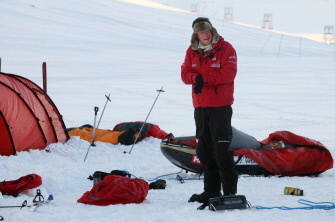 GENEVA
GENEVA

Britain's Prince Harry takes down his tent during training with the Walking with the Wounded team as they prepare to set off to walk to the North Pole, on the island of Spitsbergen, situated between the Norwegian mainland and the North Pole, on March 31, 2011. Britain's Prince Harry will join the team for the first five days of the trek to the North Pole. AFP
The Arctic ozone layer suffered a loss of about 40 percent from the beginning of winter to late March, up from the previous record of about 30 percent over the entire winter, according to the World Meteorological Organisation.
"Depletion of the ozone layer -- the shield that protects life on Earth from harmful levels of ultraviolet rays -- has reached an unprecedented level over the
With the ozone poor region shifting away in late March from the pole to cover Greenland and
"As the solar elevation at noon increases over the next weeks, regions affected by the ozone depletion will experience higher than normal UV radiation," said the WMO.
"The public is recommended to stay informed through national UV forecasts," it added.
Stratospheric ozone provides a natural protective filter against harmful ultra-violet rays from the sun, which can cause sunburn, cataracts and skin cancer and damage vegetation.
Its depletion is caused by extreme cold temperatures at high altitude and a particular type of pollution, from chemicals often used in refrigeration, some plastic foams, or aerosol sprays, which have accumulated in the atmosphere.
Most of the chemicals, chloroflurocarbons (CFCs), are being phased out under the 1987 Montreal Protocol, but they linger in the atmosphere for many years.
Thanks to the accord, however, the ozone layer outside the polar regions is projected to recover to its pre-1980 levels at around 2030 to 2040.
Over the Antarctic, the ozone layer is expected to recover at around 2045 to 2060 while over the Arctic, this should happen one or two decades earlier.
"The degree of ozone loss experienced in any particular winter depends on the meteorological conditions," noted Michel Jarraud, WMO secretary-general.
"The 2011 ozone loss shows that we have to remain vigilant and keep a close eye on the situation in the

 Previous page
Previous page Back to top
Back to top







